The antibacterial finishes market is projected to grow from USD 1,162.4 million in 2025 to USD 1,754.1 million by 2035, reflecting a compound annual growth rate (CAGR) of 4.2%. This growth trajectory indicates a steady increase in the demand for antimicrobial-treated textiles and surfaces across various industries, including healthcare, textiles, and consumer goods. The continued rise in consumer health awareness, combined with increased focus on hygiene, is likely to drive demand for antibacterial finishes, particularly in products used in high-touch environments such as hospitals, public spaces, and personal protective equipment (PPE).
The increasing adoption of antibacterial coatings in fabrics, medical devices, and flooring materials is driving market growth as industries strive to mitigate the spread of infectious agents.
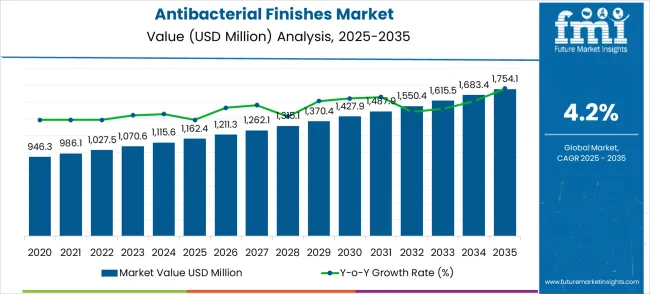
Over the next decade, the market is expected to witness incremental yearly growth, with a consistent upward trend in adoption across multiple sectors. The growing emphasis on health and hygiene is expected to drive the demand for products with antibacterial properties, especially in the aftermath of global health crises that have heightened concerns about cleanliness.
Antibacterial finishes are being incorporated into more consumer and industrial applications as companies seek to provide safer environments. This market expansion is not just driven by higher awareness but also by increased regulatory requirements that mandate the use of antimicrobial treatments in certain industries. As more sectors prioritize hygiene, the antibacterial finishes market is set to experience robust growth, positioning it as a key player in health and safety solutions.
| Metric | Value |
|---|---|
| Market Value (2025) | USD 1,162.4 million |
| Market Forecast Value (2035) | USD 1,754.1 million |
| Market Forecast CAGR | 4.2% |
The antibacterial finishes market has gained prominence within the textile finishes market, contributing around 18% of the total share, driven by increasing demand for antimicrobial-treated fabrics. In the functional fabrics market, it holds a 12% share, as antibacterial properties are integral for performance fabrics used in various industries. The healthcare textiles market sees around 10%, as these finishes are essential for hospital and medical garments. In the consumer goods market, the market share is approximately 6%, owing to antibacterial treatments applied in everyday items like towels and bed linens. Finally, within the home textiles market, the antibacterial finishes market captures about 8%, where demand is rising for hygienic home textile products. The combined figures emphasize the broad applicability of antibacterial finishes in several sectors.
Market expansion is being supported by the rapid increase in hygiene awareness worldwide and the corresponding need for advanced antimicrobial solutions that provide superior bacterial inhibition capabilities and surface protection reliability for critical healthcare and industrial applications. Modern healthcare facilities and textile manufacturers rely on consistent antimicrobial performance and surface protection to ensure optimal infection control including hospital environments, medical textiles, and food processing facilities. Even minor antimicrobial inefficiencies can require comprehensive surface treatment adjustments to maintain optimal hygiene standards and infection prevention.
The growing complexity of antimicrobial requirements and increasing demand for long-lasting antibacterial solutions are driving demand for antibacterial finishes from certified manufacturers with appropriate performance capabilities and technical expertise. Healthcare operators are increasingly requiring documented antimicrobial effectiveness and durability standards to maintain surface hygiene quality and operational safety. Industry specifications and performance standards are establishing standardized antimicrobial procedures that require specialized finish technologies and trained application personnel.
The Antibacterial Finishes market is entering a new phase of growth, driven by demand for infection control, hygiene enhancement, and evolving antimicrobial and safety standards. By 2035, these pathways together can unlock USD 350-450 million in incremental revenue opportunities beyond baseline growth.
Pathway A -- Material Innovation Leadership (Metal-Based Solutions) The metal-based segment already holds the largest share due to its superior effectiveness and proven performance. Expanding antimicrobial optimization, durability enhancement, and application efficiency can consolidate leadership. Opportunity pool: USD 80-100 million.
Pathway B -- Core Infrastructure Applications (Water Treatment) Water treatment accounts for the largest demand. Growing industrial water treatment infrastructure, especially in emerging economies, will drive higher adoption of antibacterial finishes for system protection. Opportunity pool: USD 70-90 million.
Pathway C -- Healthcare Facility Expansion (Medical Applications) Healthcare applications represent significant growth potential with increasing infection control requirements. Systems optimized for healthcare environments can capture substantial growth. Opportunity pool: USD 60-75 million.
Pathway D -- Emerging Market Expansion Asia-Pacific and Latin America present growing demand due to rising hygiene standards. Targeting cost-competitive solutions and local partnerships will accelerate adoption. Opportunity pool: USD 50-65 million.
Pathway E -- Textile Industry Integration With increasing antimicrobial textile demand, there is an opportunity to promote finishes optimized for textile manufacturing and treatment. Opportunity pool: USD 40-50 million.
Pathway F -- Specialized Applications (Agriculture & Food Processing) Systems optimized for agricultural equipment, food processing facilities, and specialized applications offer premium positioning for high-safety sectors. Opportunity pool: USD 30-35 million.
Pathway G -- Service Integration & Performance Monitoring Recurring revenue from application services, performance testing, and effectiveness monitoring creates long-term revenue streams. Opportunity pool: USD 15-20 million.
Pathway H -- Smart Surface Integration & IoT Monitoring Digital antimicrobial monitoring, intelligent surface protection, and IoT integration can elevate finishes into comprehensive hygiene management systems. Opportunity pool: USD 5-15 million.
The market is segmented by material type, application, and region. By material type, the market is divided into metal-based, organic compound-based, nanomaterial-based, bio-based, and other antibacterial finish materials. Based on application, the market is categorized into water treatment, healthcare, textile, agriculture, and other applications. Regionally, the market is divided into North America, Europe, East Asia, South Asia & Pacific, Latin America, and Middle East & Africa.
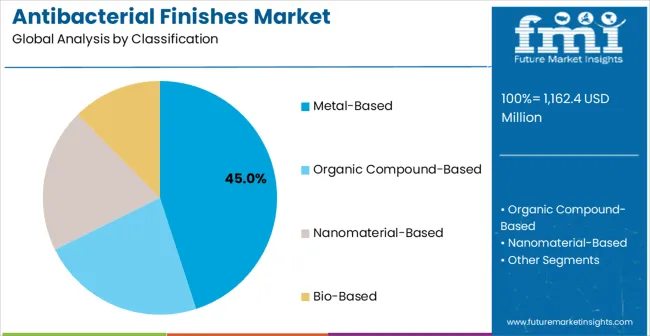
In 2025, the metal-based antibacterial finishes segment is projected to capture around 45% of the total market share, making it the leading material type category. This dominance is largely driven by the widespread adoption of silver and copper-based antimicrobial solutions that provide optimal balance between effectiveness and durability, catering to a wide variety of healthcare and industrial applications. Metal-based finishes are particularly favored for their ability to deliver superior antimicrobial performance and long-lasting protection in both healthcare facility and textile manufacturing installations, ensuring surface hygiene and sustained antibacterial effectiveness. Healthcare facilities, textile manufacturers, water treatment providers, and food processing applications increasingly prefer this configuration, as it meets demanding antimicrobial requirements without imposing excessive cost constraints or application complexity.
The availability of well-established manufacturing processes, along with comprehensive technical support options and standardized application methods from leading suppliers, further reinforces the segment's market position. Additionally, this material type category benefits from consistent demand across regions, as it is considered a proven and reliable solution for facilities requiring effective antimicrobial protection and operational safety. The combination of antimicrobial effectiveness, durability performance, and application versatility makes metal-based antibacterial finishes a dependable choice, ensuring their continued popularity in the healthcare and industrial markets.
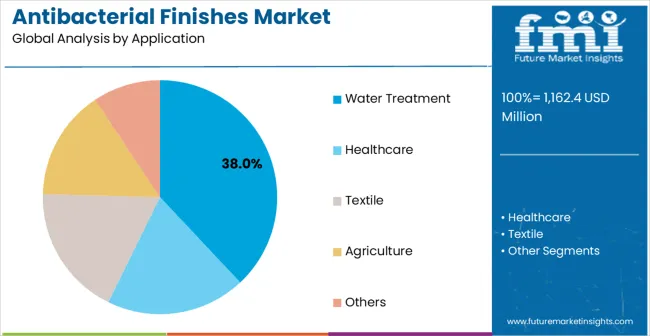
The water treatment segment is expected to represent 38% of antibacterial finishes demand in 2025, highlighting its position as the most significant application sector. This dominance stems from the critical antimicrobial requirements of modern water treatment facilities, where bacterial control and biofilm prevention are essential to water quality and system performance. Water treatment systems often feature extensive surface areas that demand specialized antibacterial finishes throughout complex infrastructure networks, requiring reliable and long-lasting antimicrobial solutions. Antibacterial finishes are particularly well-suited to these environments due to their ability to provide consistent bacterial inhibition and biofilm control, even during intensive water processing operations and varying chemical conditions. As water quality standards become more stringent globally and emphasize improved safety requirements, the demand for antibacterial finishes continues to rise.
The segment also benefits from heightened environmental health requirements within the water industry, where operators are increasingly prioritizing antimicrobial effectiveness and system reliability as essential operational measures. With water treatment facilities investing in advanced surface protection and biofilm prevention technologies, antibacterial finishes provide an essential component to maintain high-performance water quality standards. The growth of industrial water treatment and municipal water systems, coupled with increased focus on infection prevention standards, ensures that water treatment will remain the largest and most stable demand driver for antibacterial finishes in the forecast period.
The Antibacterial Finishes market is advancing rapidly due to increasing hygiene awareness and growing recognition of antimicrobial surface treatment advantages over traditional coating solutions in infection-critical applications. However, the market faces challenges including higher material costs compared to conventional alternatives, need for specialized application and performance testing procedures, and complex regulatory requirements with antimicrobial efficacy standards across different industrial environments. Performance optimization efforts and advanced antimicrobial technology programs continue to influence product development and market adoption patterns.
The growing development of advanced nanomaterial-based finishes and enhanced antimicrobial systems is enabling superior bacterial inhibition capacity with improved durability and reduced environmental impact. Advanced nanotechnology applications and optimized particle designs provide superior antimicrobial performance while maintaining surface compatibility requirements. These technologies are particularly valuable for healthcare operators who require reliable antimicrobial effectiveness that can support extensive surface treatment operations with consistent long-term results.
Modern antibacterial finish manufacturers are incorporating advanced responsive technologies and intelligent antimicrobial systems that enhance surface protection and operational effectiveness. Integration of smart release mechanisms and optimized antimicrobial delivery systems enables superior infection control and comprehensive surface management capabilities. Advanced responsive features support operation in diverse environmental conditions while meeting various antimicrobial requirements and safety specifications.
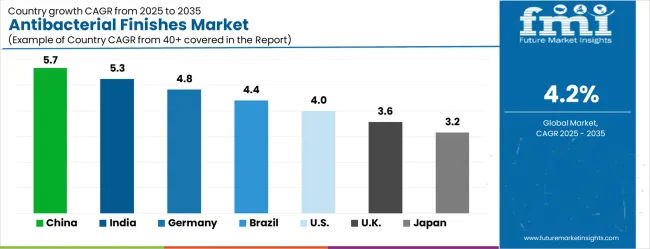
| Country | CAGR (2025-2035) |
|---|---|
| China | 5.7% |
| India | 5.3% |
| Germany | 4.8% |
| Brazil | 4.4% |
| United States | 4.0% |
| United Kingdom | 3.6% |
| Japan | 3.2% |
The antibacterial finishes market is growing steadily, with China leading at a 5.7% CAGR through 2035, driven by expanding healthcare infrastructure and increasing adoption of antimicrobial surface treatment solutions. India follows at 5.3%, supported by rising hygiene awareness and growing implementation of infection control technologies. Germany grows strongly at 4.8%, integrating advanced antimicrobial technology into its established chemical manufacturing sector. Brazil records 4.4%, emphasizing healthcare infrastructure development and surface treatment modernization initiatives. The United States shows solid growth at 4.0%, focusing on healthcare facility enhancement and antimicrobial innovation. The United Kingdom demonstrates steady progress at 3.6%, maintaining established healthcare applications. Japan records 3.2% growth, concentrating on technology advancement and antimicrobial efficiency optimization.
The report covers an in-depth analysis of 40+ countries, the top-performing countries are highlighted below.
The antibacterial finishes market in China is projected to exhibit the highest growth rate with a CAGR of 5.7% through 2035, driven by unprecedented expansion of healthcare infrastructure and increasing demand for antimicrobial surface treatment solutions. The country's massive healthcare sector and expanding medical facility construction are creating enormous demand for advanced antibacterial finish solutions. Major healthcare providers are establishing comprehensive infection control systems to support the increasing requirements of medical facilities and healthcare service companies across metropolitan regions.
Government healthcare development initiatives are supporting establishment of modern medical facilities and advanced antimicrobial treatment complexes, driving demand for high-performance antibacterial finishes throughout major healthcare zones. Healthcare sector modernization programs are facilitating adoption of antimicrobial surface technologies that enhance infection control efficiency and safety standards across medical infrastructure networks.
The antibacterial finishes market in India is expanding at a CAGR of 5.3%, supported by increasing hygiene awareness and growing implementation of infection control technologies. The country's expanding healthcare infrastructure and rising antimicrobial treatment standards are driving demand for advanced antibacterial finish solutions. Healthcare facilities and textile manufacturers are gradually implementing high-performance antimicrobial equipment to maintain competitive standards and operational safety.
Healthcare sector growth and hygiene infrastructure development are creating opportunities for suppliers that can support diverse antimicrobial requirements and performance specifications. Professional training and technical programs are building expertise among application personnel, enabling effective utilization of antibacterial finish technology that meets healthcare standards and infection control requirements.
The antibacterial finishes market in Germany is projected to grow at a CAGR of 4.8%, supported by the country's emphasis on chemical industry quality standards and advanced antimicrobial technology adoption. German healthcare and manufacturing facilities are implementing sophisticated antimicrobial systems that meet stringent performance requirements and operational specifications. The market is characterized by focus on antimicrobial effectiveness, surface protection excellence, and compliance with comprehensive safety standards.
Chemical industry investments are prioritizing cutting-edge antimicrobial technology that demonstrates superior performance and reliability while meeting German quality and efficiency standards. Professional certification programs are ensuring comprehensive technical expertise among application personnel, enabling specialized antimicrobial capabilities that support diverse healthcare and industrial applications.
The antibacterial finishes market in Brazil is growing at a CAGR of 4.4%, driven by increasing healthcare infrastructure development and growing recognition of antimicrobial surface treatment advantages. The country's expanding healthcare sector is gradually integrating advanced antimicrobial solutions to enhance infection control and service quality. Healthcare facilities and industrial manufacturers are investing in antibacterial finish technology to address evolving hygiene requirements and safety standards.
Healthcare infrastructure modernization is facilitating adoption of advanced antimicrobial technologies that support comprehensive infection control capabilities across healthcare regions. Professional development programs are enhancing technical capabilities among application personnel, enabling effective antibacterial finish utilization that meets evolving healthcare standards and performance requirements.
The antibacterial finishes market in the USA is expanding at a CAGR of 4.0%, driven by established healthcare industries and growing emphasis on infection control enhancement. Large healthcare providers and industrial manufacturers are implementing comprehensive antibacterial finish capabilities to serve diverse antimicrobial requirements. The market benefits from established chemical industry distribution systems and professional development programs that support various healthcare and industrial applications.
Healthcare industry leadership is enabling standardized antimicrobial utilization across multiple facility types, providing consistent performance standards and comprehensive infection control coverage throughout regional markets. Professional development and certification programs are building specialized technical expertise among application personnel, enabling effective antibacterial finish utilization that supports evolving healthcare facility requirements.
The antibacterial finishes market in the UK is projected to grow at a CAGR of 3.6%, supported by established healthcare sectors and growing emphasis on antimicrobial performance capabilities. British healthcare facilities and industrial service providers are implementing antibacterial finish systems that meet industry performance standards and operational requirements. The market benefits from established healthcare infrastructure and comprehensive training programs for technical professionals.
Healthcare facility investments are prioritizing advanced antimicrobial solutions that support diverse infection control applications while maintaining established performance and safety standards. Professional development programs are building technical expertise among application personnel, enabling specialized antibacterial finish operation capabilities that meet evolving facility requirements and performance standards.
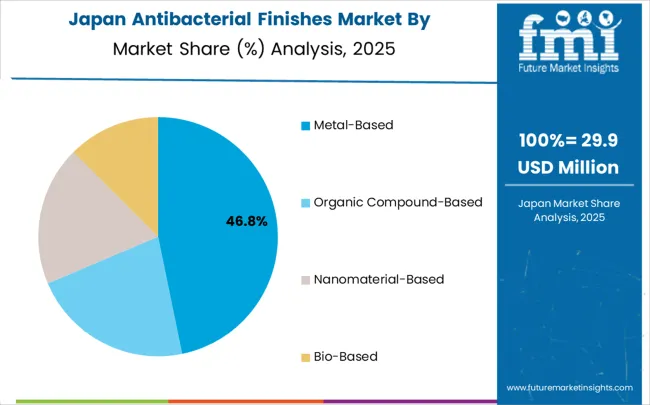
The antibacterial finishes market in Japan is growing at a CAGR of 3.2%, driven by the country's focus on antimicrobial technology innovation and surface protection applications. Japanese healthcare facilities and industrial manufacturers are implementing advanced antibacterial finish systems that demonstrate superior performance reliability and operational consistency. The market is characterized by emphasis on technological excellence, quality assurance, and integration with established manufacturing workflows.
Antimicrobial technology investments are prioritizing innovative surface protection solutions that combine advanced antibacterial finish technology with precision application while maintaining Japanese quality and reliability standards. Professional development programs are ensuring comprehensive technical expertise among application personnel, enabling specialized antimicrobial capabilities that support diverse healthcare and industrial applications.
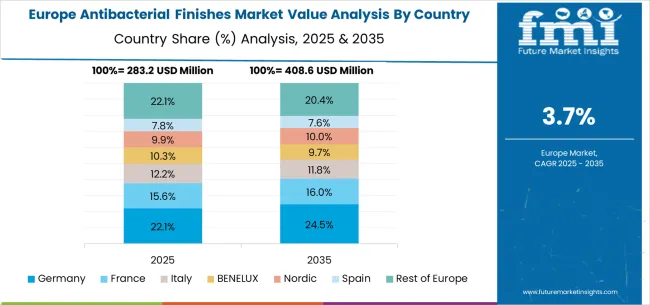
The antibacterial finishes market in Europe is forecast to expand from USD 304.2 million in 2025 to USD 458.8 million by 2035, registering a CAGR of 4.2%. Germany will remain the largest market, holding 31.4% share in 2025, easing to 30.8% by 2035, supported by strong chemical infrastructure and advanced antimicrobial standards. The United Kingdom follows, rising from 23.1% in 2025 to 23.6% by 2035, driven by healthcare facility modernization and infection control enhancement initiatives. France is expected to maintain stability from 18.5% to 18.2%, reflecting consistent chemical industry investments and antimicrobial requirements. Italy holds around 12.7% throughout the forecast period, supported by healthcare facility upgrades and infection control modernization programs. Spain grows from 8.9% to 9.2% with expanding healthcare infrastructure and increased focus on antimicrobial surface solutions. BENELUX markets maintain 3.8% to 3.6%, while the remainder of Europe hovers near 1.6%--1.6%, balancing emerging Eastern European healthcare development against mature Nordic markets with established antimicrobial technology adoption patterns.
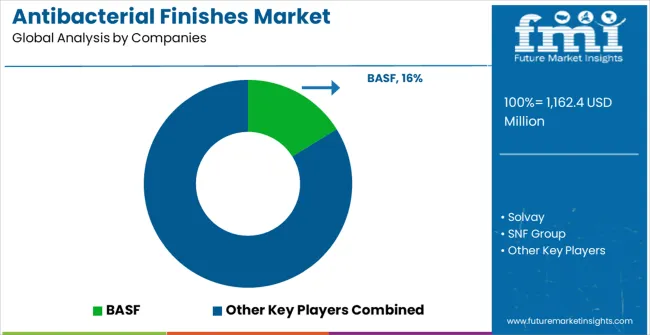
The Antibacterial Finishes market is defined by competition among specialized chemical manufacturers, antimicrobial technology companies, and surface treatment solution providers. Companies are investing in advanced antimicrobial technology development, finish innovation, performance optimization, and comprehensive application service capabilities to deliver reliable, effective, and cost-efficient antibacterial solutions. Strategic partnerships, technological innovation, and market expansion are central to strengthening product portfolios and market presence.
BASF offers comprehensive chemical solutions with established manufacturing expertise and professional-grade antimicrobial capabilities. Solvay provides specialized chemical systems with focus on performance reliability and operational effectiveness. SNF Group delivers advanced antimicrobial solutions with emphasis on efficiency optimization and application-friendly operation. Dow specializes in chemical technology with advanced manufacturing integration.
Ashland offers professional-grade chemical equipment with comprehensive technical support capabilities. Kemira delivers established industrial solutions with advanced antimicrobial technologies. Ecolab provides specialized treatment equipment with focus on performance optimization. Evonik, Lonza Group, Lubrizol, Arkema, Mitsubishi Chemical, Croda International, Zschimmer & Schwarz, Lamberti, Chemigate, Merichem, Italmatch Chemicals, and Innospec offer specialized manufacturing expertise, product reliability, and comprehensive development across global and regional chemical market segments.
| Item | Value |
|---|---|
| Quantitative Units | USD 1,162.4 million |
| Material Type | Metal-Based, Organic Compound-Based, Nanomaterial-Based, and Bio-Based |
| Application | Water Treatment, Healthcare, Textile, Agriculture, Other |
| Regions Covered | North America, Europe, East Asia, South Asia & Pacific, Latin America, Middle East & Africa |
| Country Covered | China, India, Germany, Brazil, United States, United Kingdom, Japan, and 40+ countries |
| Key Companies Profiled | BASF, Solvay, SNF Group, Dow, Ashland, Kemira, Ecolab, Evonik, Lonza Group, Lubrizol, Arkema, Mitsubishi Chemical, Croda International, Zschimmer & Schwarz, Lamberti, Chemigate, Merichem, Italmatch Chemicals, Innospec |
| Additional Attributes | Dollar sales by material type and application segment, regional demand trends across major markets, competitive landscape with established chemical manufacturers and emerging antimicrobial providers, customer preferences for different finish configurations and performance options, integration with surface treatment systems and antimicrobial protocols, innovations in antibacterial technology and application efficiency, and adoption of advanced antimicrobial features with enhanced durability capabilities for improved hygiene workflows. |
The global antibacterial finishes market is estimated to be valued at USD 1,162.4 million in 2025.
The market size for the antibacterial finishes market is projected to reach USD 1,754.1 million by 2035.
The antibacterial finishes market is expected to grow at a 4.2% CAGR between 2025 and 2035.
The key product types in antibacterial finishes market are metal-based, organic compound-based, nanomaterial-based and bio-based.
In terms of application, water treatment segment to command 38.0% share in the antibacterial finishes market in 2025.






Our Research Products

The "Full Research Suite" delivers actionable market intel, deep dives on markets or technologies, so clients act faster, cut risk, and unlock growth.

The Leaderboard benchmarks and ranks top vendors, classifying them as Established Leaders, Leading Challengers, or Disruptors & Challengers.

Locates where complements amplify value and substitutes erode it, forecasting net impact by horizon

We deliver granular, decision-grade intel: market sizing, 5-year forecasts, pricing, adoption, usage, revenue, and operational KPIs—plus competitor tracking, regulation, and value chains—across 60 countries broadly.

Spot the shifts before they hit your P&L. We track inflection points, adoption curves, pricing moves, and ecosystem plays to show where demand is heading, why it is changing, and what to do next across high-growth markets and disruptive tech

Real-time reads of user behavior. We track shifting priorities, perceptions of today’s and next-gen services, and provider experience, then pace how fast tech moves from trial to adoption, blending buyer, consumer, and channel inputs with social signals (#WhySwitch, #UX).

Partner with our analyst team to build a custom report designed around your business priorities. From analysing market trends to assessing competitors or crafting bespoke datasets, we tailor insights to your needs.
Supplier Intelligence
Discovery & Profiling
Capacity & Footprint
Performance & Risk
Compliance & Governance
Commercial Readiness
Who Supplies Whom
Scorecards & Shortlists
Playbooks & Docs
Category Intelligence
Definition & Scope
Demand & Use Cases
Cost Drivers
Market Structure
Supply Chain Map
Trade & Policy
Operating Norms
Deliverables
Buyer Intelligence
Account Basics
Spend & Scope
Procurement Model
Vendor Requirements
Terms & Policies
Entry Strategy
Pain Points & Triggers
Outputs
Pricing Analysis
Benchmarks
Trends
Should-Cost
Indexation
Landed Cost
Commercial Terms
Deliverables
Brand Analysis
Positioning & Value Prop
Share & Presence
Customer Evidence
Go-to-Market
Digital & Reputation
Compliance & Trust
KPIs & Gaps
Outputs
Full Research Suite comprises of:
Market outlook & trends analysis
Interviews & case studies
Strategic recommendations
Vendor profiles & capabilities analysis
5-year forecasts
8 regions and 60+ country-level data splits
Market segment data splits
12 months of continuous data updates
DELIVERED AS:
PDF EXCEL ONLINE
Antibacterial Hydrophilic Aluminum Foil Market Forecast and Outlook 2025 to 2035
Antibacterial Haemostatic Gels Market - Trends & Forecast 2025 to 2035
Urinary Antibacterial & Antiseptic Pharmaceuticals Market Analysis – Forecast 2025 to 2035

Thank you!
You will receive an email from our Business Development Manager. Please be sure to check your SPAM/JUNK folder too.
Chat With
MaRIA